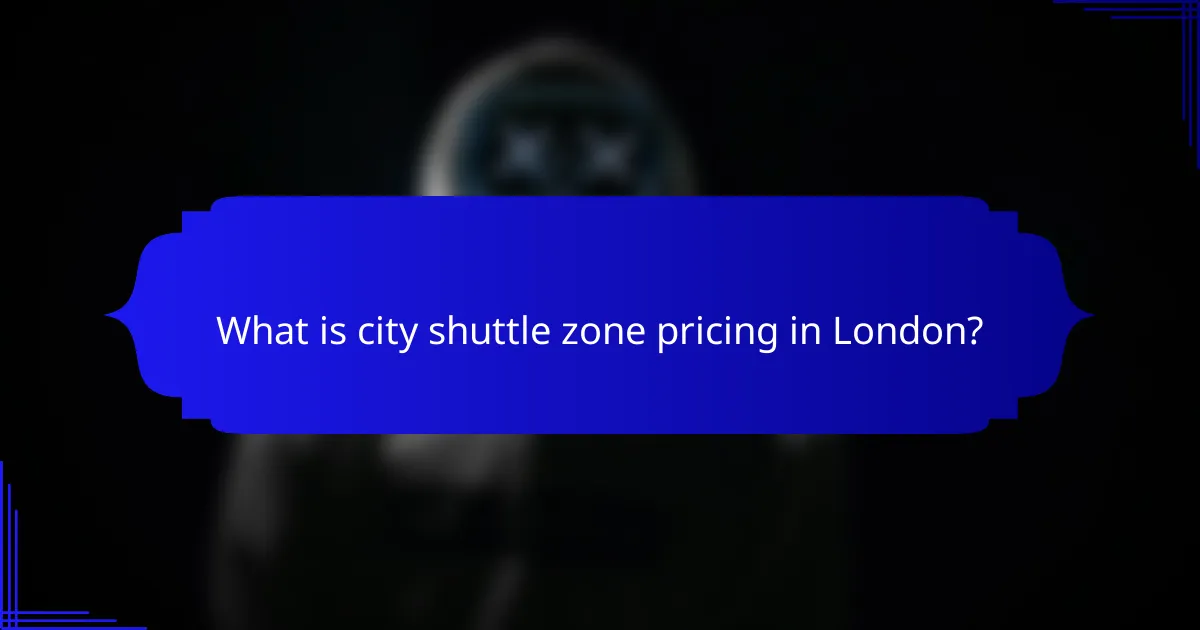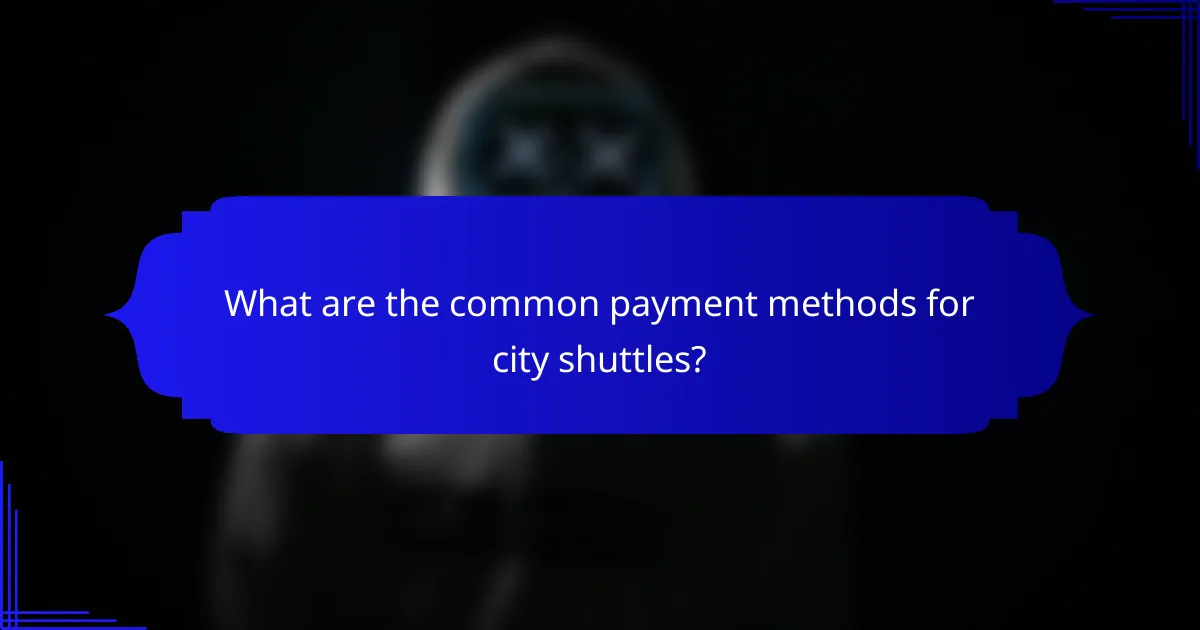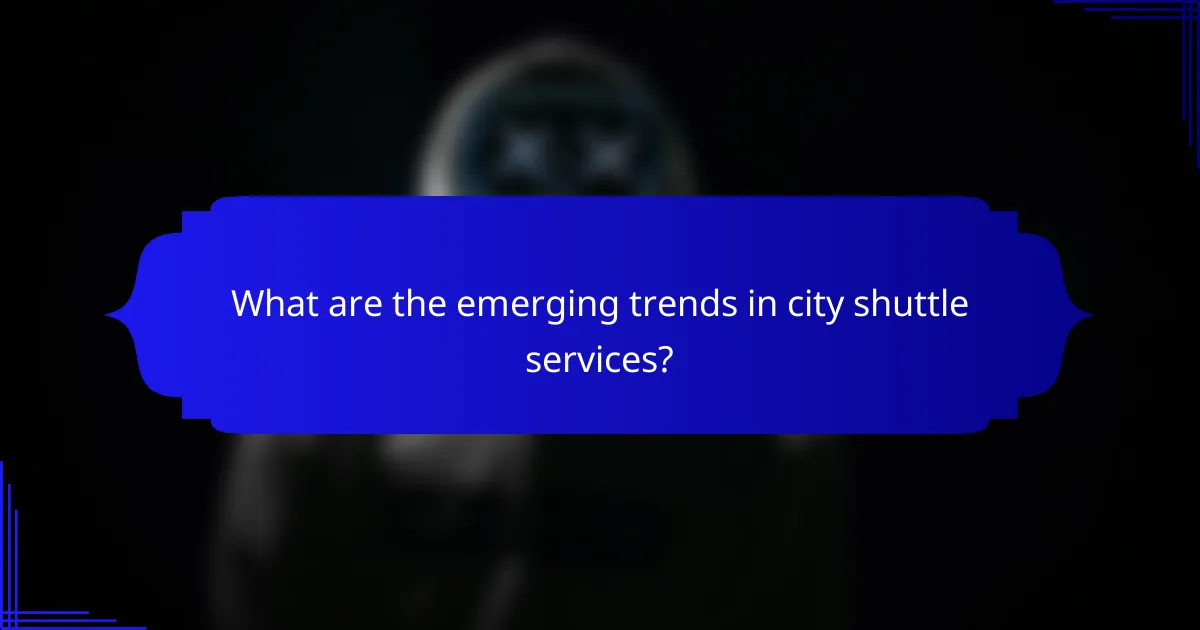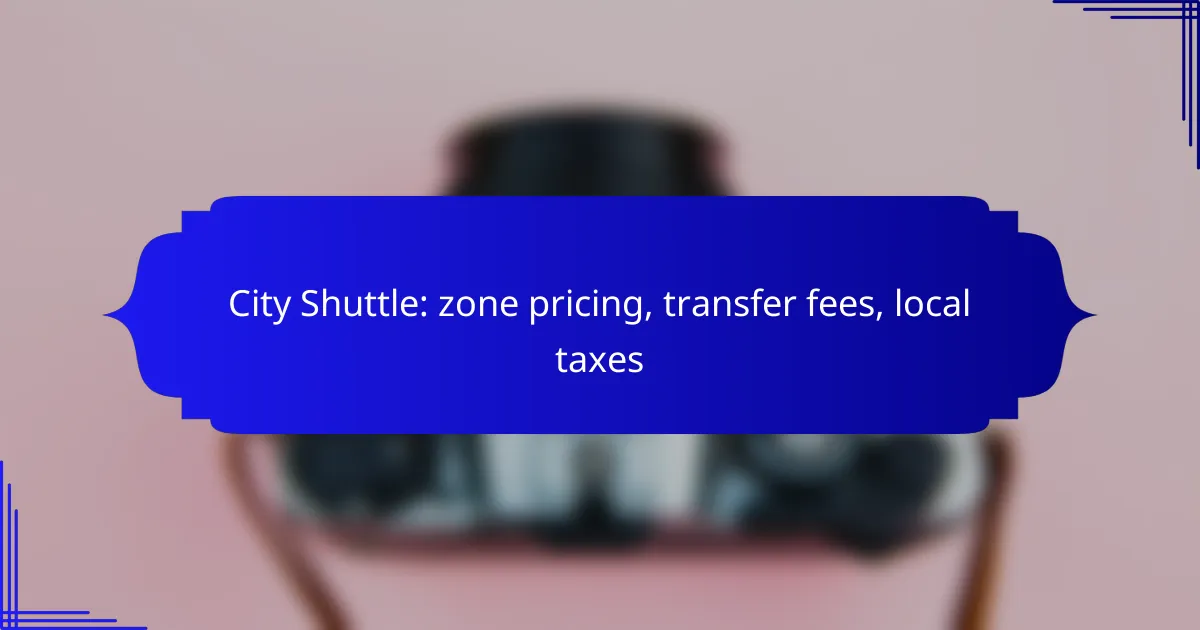City shuttle services often implement zone pricing, where fares vary based on the geographical zones passengers travel through. Understanding these zones is crucial for accurately estimating costs, as well as being aware of transfer fees that can range from £5 to £20 when switching services. Additionally, local taxes can significantly affect overall pricing, adding extra costs that vary by municipality and may lead to higher fares for users.

What is city shuttle zone pricing in London?
City shuttle zone pricing in London refers to the fare structure based on geographical zones within the city. Passengers pay different rates depending on the zones they travel between, making it essential to understand the zone layout to estimate costs accurately.
Fixed rates based on zones
Fixed rates for city shuttles are determined by the specific zones of departure and arrival. For example, traveling from Zone 1 to Zone 2 typically incurs a set fare, which can range from £2 to £5, depending on the shuttle service. Knowing the zones helps passengers budget their travel expenses effectively.
Many shuttle services publish their zone maps and fare schedules online, allowing users to plan their trips in advance. Always check these resources to avoid unexpected charges.
Dynamic pricing during peak hours
Dynamic pricing applies to city shuttles during peak hours, where fares can increase significantly based on demand. For instance, a journey that costs £3 during off-peak times might rise to £6 or more when demand is high. This pricing strategy encourages passengers to travel during less busy times.
To save on costs, consider adjusting your travel schedule to avoid peak hours. Additionally, some shuttle services offer discounts or fixed rates for off-peak travel, providing further savings opportunities.

What are the transfer fees for city shuttles in the UK?
Transfer fees for city shuttles in the UK typically range between £5 to £20, depending on the distance and specific service provider. These fees are charged when passengers switch from one shuttle service to another within the same journey.
Standard transfer fee structure
The standard transfer fee structure for city shuttles in the UK varies by operator and route. Most services charge a flat fee for transfers, which can be included in the overall ticket price or added as a separate charge. For example, a transfer between two major city hubs might cost around £10.
It’s essential to check with the specific shuttle company for their fee schedule, as some may offer discounts for round trips or group bookings. Always inquire about any promotional offers that could reduce your overall costs.
Additional fees for extra luggage
City shuttles in the UK often impose additional fees for extra luggage beyond a standard allowance. Typically, the first piece of luggage is included in the ticket price, while subsequent bags may incur charges ranging from £2 to £5 each.
Passengers should confirm the luggage policy of their chosen shuttle service before traveling to avoid unexpected costs. Some companies may have weight limits or size restrictions, so it’s wise to pack accordingly and check the terms of service for clarity.

How do local taxes affect city shuttle pricing?
Local taxes significantly influence city shuttle pricing by adding extra costs that are passed on to passengers. These taxes can vary widely depending on the municipality, impacting overall fare structures and potentially leading to higher prices for users.
VAT implications on shuttle services
Value Added Tax (VAT) is often applied to shuttle services, affecting the final fare. In many countries, this tax can range from around 5% to 25%, depending on local regulations. Shuttle operators must include this tax in their pricing, which can make services more expensive for consumers.
For example, if a shuttle fare is set at $10 and the VAT is 10%, the total cost to the passenger would be $11. Operators should ensure they are compliant with VAT regulations to avoid penalties.
Local council tax variations
Local council taxes can differ significantly between regions, impacting shuttle pricing. These taxes may be levied on transportation services, which can lead to increased operational costs for shuttle providers. As a result, fares may be adjusted to accommodate these additional expenses.
For instance, in a city where local council tax adds an extra $1 to each fare, passengers in that area may find themselves paying more than in a neighboring city with no such tax. It’s advisable for passengers to be aware of these variations when planning their travel budgets.

What factors influence city shuttle pricing in major UK cities?
City shuttle pricing in major UK cities is influenced by several key factors, including the distance between zones and the time of day along with demand. Understanding these elements can help passengers anticipate costs and plan their journeys more effectively.
Distance between zones
The distance between zones is a primary factor affecting city shuttle pricing. Generally, the further you travel, the higher the fare. For instance, a trip within a single zone may cost around £2-£4, while traveling across multiple zones could increase the fare to £5-£10 or more, depending on the city.
Many shuttle services implement a tiered pricing structure based on the number of zones crossed. Passengers should check specific fare charts provided by the shuttle service to understand the cost implications of their journey.
Time of day and demand
The time of day significantly impacts city shuttle pricing, particularly during peak hours when demand is high. Fares may increase during morning and evening rush hours, often by 20-30%. Conversely, off-peak travel can offer lower rates, making it more economical for passengers who can adjust their schedules.
Additionally, some shuttle services may introduce dynamic pricing, where fares fluctuate based on real-time demand. It’s advisable to plan trips during less busy times to take advantage of lower fares and avoid potential surcharges.

How to choose the best city shuttle service?
To choose the best city shuttle service, consider factors like pricing, customer reviews, and service reliability. Evaluating these aspects will help you find a shuttle that meets your needs and budget.
Comparing customer reviews
Customer reviews provide insights into the experiences of previous riders, highlighting strengths and weaknesses of different shuttle services. Look for platforms like Google Reviews or Yelp to gather a range of opinions.
Pay attention to recurring themes in the reviews, such as punctuality, cleanliness, and driver professionalism. A service with consistently high ratings is often a safer bet.
Evaluating service reliability
Service reliability is crucial when selecting a city shuttle. Check if the shuttle operates on a fixed schedule and how often it runs, especially during peak hours. Reliable services typically have a frequency of every 15-30 minutes.
Additionally, consider the shuttle’s track record for on-time arrivals. Services that provide real-time tracking can offer peace of mind, allowing you to plan your travel more effectively.

What are the common payment methods for city shuttles?
City shuttles typically accept a variety of payment methods, making it convenient for passengers to pay for their rides. The most common options include credit and debit cards, as well as mobile payment applications, ensuring flexibility for users.
Credit and debit card options
Credit and debit cards are widely accepted for city shuttle payments, allowing passengers to pay directly at kiosks or onboard. Most shuttles support major card networks like Visa, MasterCard, and American Express.
When using a card, be aware of potential transaction fees that may apply, especially for international cards. It’s advisable to check with the shuttle service for any additional charges or restrictions before your trip.
Mobile payment applications
Mobile payment applications, such as Apple Pay, Google Pay, and various local apps, are increasingly popular for city shuttle transactions. These apps offer a quick and secure way to pay without needing to carry cash or cards.
To use mobile payments, ensure that your device is compatible and that the shuttle service accepts your preferred app. Some services may offer discounts or promotions for using mobile payments, so it’s worth checking for any available offers.

What are the benefits of using city shuttles over taxis?
City shuttles offer several advantages over taxis, including lower costs for group travel and a more predictable pricing structure. These benefits make shuttles an appealing choice for both individuals and groups looking to navigate urban areas efficiently.
Cost-effectiveness for group travel
City shuttles are particularly cost-effective for group travel, as they typically charge a flat rate per vehicle rather than per passenger. This means that the more people you travel with, the less you pay per person, making shuttles a budget-friendly option for families or groups of friends.
For example, a shuttle service might charge around $50 for a ride that accommodates up to 10 passengers, while a taxi could cost $20 to $30 for a single trip. This significant difference highlights the savings potential when traveling in a group.
Predictable pricing structure
City shuttles often feature a predictable pricing structure that helps travelers avoid unexpected charges. Unlike taxis, which may have variable rates based on traffic or time of day, shuttles usually provide clear pricing information upfront, allowing for better budgeting.
Many shuttle services list their rates online, making it easy to compare costs before booking. Additionally, some shuttles may offer fixed rates for specific routes, ensuring that travelers know exactly what to expect in terms of pricing.

What are the emerging trends in city shuttle services?
City shuttle services are increasingly adopting flexible pricing models, integrating with public transport, and enhancing user experience through technology. These trends aim to improve accessibility, reduce congestion, and provide cost-effective transportation options for urban dwellers.
Integration with public transport systems
Integration with public transport systems allows city shuttles to operate more efficiently and provide seamless travel experiences. By coordinating schedules and routes, shuttles can fill gaps in public transport, making it easier for passengers to transition between different modes of transport.
For example, a city shuttle might align its service times with local bus or train schedules, reducing wait times for passengers. This can lead to increased ridership and a more cohesive urban transport network, ultimately benefiting the environment by encouraging public transport use over personal vehicles.
To ensure successful integration, city planners and shuttle operators should focus on clear communication and user-friendly apps that provide real-time updates on shuttle arrivals and connections. Avoiding common pitfalls, such as poorly timed connections or lack of information, is crucial for maximizing the benefits of this integration.
